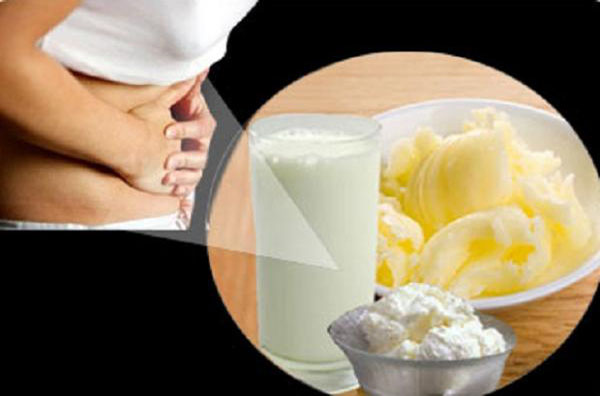Food with lactose deficiency in adults. Lactose insufficiency in newborns: symptoms and possible treatment.
Our article will talk about the extremely acute and controversial topic in modern pediatrics. Lactasine failure is a diagnosis that some other ten years ago read only in scientific articles. Today, this term has become a kind of brand or a fashionable diagnosis, from which each third child is treated. Due to the increasing number of small patients, the number of bounces of breastfeeding increases and the number of sales is extremely nothesive as low -landose mixtures and lactase preparations. How is it really the case?
Lactose is much better tolerated among nomadic peoples North Africathan among seats, which is explained by the fact that nomads move with their herds and consume a large number of Cow Milk, goat milk Or the sheep of many generations and their organisms adapted to this diet and for centuries developed the ability of lactase production sufficient so that they can digest milk and its derivatives.
Meteorism, diarrhea, nausea, colic and abdominal pain can be signs of lactose intolerance, which, of course, reduces the quality of life of the patient, but can lead to more serious problems. This intolerance is a direct result and insufficient production or even a complete absence of lactase by the body.
Defining the concept and clinic
Lactasine failure is a constant or temporary lack of or reducing the activity of a special enzyme of the small intestine of lactase. The main function of this enzyme is the splitting of lactose milk sugar molecules per molecule of glucose and one galactose molecule. If there is no lactase in the small intestine or it is not enough, lactose remains untouched and subjected to fermentation processes. These processes are accompanied by the release of a large amount of gas and osmotically active substances causing diarrhea .
Therefore, we are talking about a partial or total alakademy, depending on whether the body produces little or does not have lactase at all. There are rare cases of congenital lactose intolerance due to the inability of the body to synthesize lactase. Some diseases of the digestive tract can also reduce the amount of enzyme produced.
The lactose intolerance may occur at any age and, apparently, most common among adults, as small children and especially babies often have a large number of lactase, which allows them to assimilate breast milk contains many lactose.
Hence the main symptoms and clinical manifestations of lactase deficiency:
- Fresh liquid stool.
- Owl of belly.
- Catching pain.
It is important that these symptoms appear within 1-2 hours from the moment of milk intake!
Relevance of the topic
Lactomatic insufficiency is predominantly infant disease, that is, children up to a year. It is at this age of the main food of the child is breast milk or adapted milk mixtures.
It seems that the adult and adolescent will lead, at least partially, to the loss of habits regularly consume dairy products. Distribution of lactose intolerance worldwide shows that all people are not born equal to Disaccharide! Indeed, only 4% of the Scandinavian population suffers the incidence of increasing, as one wins the southern regions.
Belgium has from 10 to 20% of lactose intolerance in its population, countries around the Mediterranean region put forward figures about 50-75%, while Africa shows an amazing rate of 80% of Asia and Far East We experience an unprecedented phenomenon with 90% intolerance to the population. it global phenomenon Tapped three quarters of the population.
This condition is also found in adults, but in this case it is rather a variant of the physiological "cultivation" of the body, rather than the disease. IN wildlife No mammal feeds with milk after going out of children's age. So in a person at the achievement of 6-7 years, the activity of the enzyme lactase fuses. It's just some adult symptoms of insufficiency will appear from a pair of sips of solid milk, and others after a liter.
Although these two phenomena are completely different, confusion is happily rejoicing between intolerance and allergies to milk! The term "intolerance" refers to the full or partial absence of an enzyme that is either the process of digesting the nutrient, or its metabolism.
The intolerance does not cause any reaction from the immune system. Allergies is characterized by an immune response to a food allergen or trofaller, usually protein. One of them is the "breathing test in hydrogen", which consists in assessing the presence of hydrogen in the air, exhaled by the patient before and after receiving 10 g of lactose in solution. The small intestine turns into gas under the action of bacteria colic, including hydrogen. This hydrogen then goes into the bloodstream to join the lungs, of which it exhales along with the air.
So, lactase insufficiency is a few species:
- Primary or congenital, when the enzyme is absent in the body in principle. This option of illness is extremely rare. According to the latest research in the world, only a few dozen people are revealed with a complete genetically determined lactase.
- Secondary or acquired failure. This situation is found much more often, but it is an absolutely passing phenomenon. Most often, secondary insufficiency develops as a result of damage to the walls of the small intestine. Causes may be:
- Intestinal infections, especially rotavirus.
- Poisoning to toxins.
- Glice invasions.
- Allergy or individual intolerance food products. For example, allergic to protein of cow milk or gluten intolerance - celiac disease.
In the elimination of these processes, lactase failure passes.
The higher the level of hydrogen in the explosion, the less effective is the digestion of lactose in the small intestine and, therefore, the less effective ability of the lactase to produce the body. You can also use the "Test for Tolerance to Lactose", which consists in measuring the blood glucose level after eating a certain amount of lactose. Recall that lactase decomposes lactose in glucose and galactose, which turns into turn in glucose. Glucose penetrates blood and raises the blood sugar level in the patient.
Also the cause of development secondary insufficiency The lactase can be a banal crisp of the child, when the enzyme is in the intestine, but its quantity is missing for increased volumes of milk.
- Transient lactase insufficiency is found in premature babies with an immature intestine. However, as the child grows, lactase begins to be produced in the necessary quantities.
- Adult lactase failure. As mentioned, it is rather an option of the norm than pathology. Adults are not so dependent on milk in their diet and can easily limit its consumption or choose a lactose milk as an alternative.
Diagnosis of lactase insufficiency
In adults, the diagnosis of lactase lactase is extremely simple and based on clinical manifestations. If the scrawling, diarrhea and pain occur within 2 hours after receiving whole milk, you can safely suspect this diagnosis. Of course, this is not a reason to make myself diagnoses yourself. With a frequent repetition of such symptoms, you need to contact a gastroenterologist to eliminate such serious diseases as a Crohn disease, intestinal infection in chronic form, celiac disease and so on.
In case of imperfect digestion of lactose, blood glucose levels increase moderately, if at all! These two tests are not recommended for breast children. early age, Since a large amount of lactose can cause a heavy diarrhea with a large risk of dehydration, which is a greater danger to a small child than an adult. In most cases, when lactose intolerance is suspected, the pediatrician will simply change the milk formula and observe the development of symptoms.
In practice, each of us can approximate its tolerance for lactose, consuming from one to two glasses of milk on an empty stomach, and then observing the appearance characteristic symptoms. Of course, lactose-containing products can no longer be consumed, but, unfortunately, it is not as simple as it seems! Lactose is often present where it is least expecting: soups, fruits, cookies, bread, cereals and medicines that often contain lactose as an excipient.
The lactase deficiency in the children of the first year of life is still a more significant and significant condition, because the milk is the basis of their diet. There are main difficulties of diagnosis.
Some manuals lead the following clinical manifestations as the basis of the diagnosis, often absolutely unreasonable:
- Fresh liquid stool.
- Frequent swelling.
- Colic, bloating.
- Restless behavior of a child when feeding.
- The presence in the chair of the unbeatable milk or mucus lumps.
- Constipation.
In contrast to these arguments, you can bring a quote from the manual World Organization Health on issues baby food: "Child chair on breastfeeding It can be absolutely any kind, frequency and regularity, under the conditions of good health of the child and its normal development! ". That is, if the baby has a liquid stool with white lumps 10 times a day, but at the same time he is gaining weight, it eats good, happy and satisfied, it can not be a sign of one or another disease!
Unfortunately, dairy products are also excluded that provide the necessary nutrients, such as calcium, which is necessary for growth in children and consolidation of bones in adults, in women in particular. Most patients with lactose intolerance suffer from partial lactase deficiency, but not a complete absence of lactose. We can emphasize the consumption of "low content products: depleted milk lactose in" Use "microbial hydrolysis lactase lactose from milk, yogurt" at home, solid cheese, soy milk and derivatives n Do not accommodate them.
- The bloating and colic are unpleasant, but absolutely the physiological state of children up to 6 months. This period of ripening of the intestine you just need to survive.
- Restless child behavior in the chest is more likely a sign of a short bridle of the language, reflux disease or inflammatory processes in oral cavity in infants.
Of course, there are a number of laboratory tests to confirm lactase deficiency.
Another decision is to correct this deficient amount of lactase by adding synthetic lactase. Such supplements should be taken over half an hour before the "threat" meals, which will allow us to normally digest products containing or perhaps containing lactose.
Milk intolerance and allergies are two different problems that may be caused by the consumption of dairy products. These diseases may be insidious to such an extent that the consumer does not always realize the origin of its problems. Milk sugar, lactose, requires a certain enzyme, lactase. This enzyme will reduce lactose on simple sugar, glucose and galactose, which will be assimilated in the small intestine. In the absence of lactase there are gastrointestinal disorders. Removeability is just the absence of lactase, it is not an immune response.
- Calais analysis for carbohydrates. It is believed that untapered carbohydrates in feces in the infants should be a little or not to be at all from older children. However, the analysis does not evaluate the content of specifically lactose, so not specific.
- Analysis on pH (acidity) feces. Imaginary lactose residues can lower feces below 5.5, which may be indirect Sign of lactase deficiency.
- Respiratory tests for maintenance in the exhaled air breakage products of lactose in the intestine. With their reduced content, it can be assumed that lactose is not decomposed in the intestine. Accordingly, there is a lactase enzyme deficiency.
- Intestinal biopsy. Invasive procedure, which is absolutely not shown in infants with the aim of diagnosing lactase insufficiency.
- Genetic analysis, which will show the presence or absence of genes responsible for lactase products. This is perhaps the most accurate diagnostic criterion. Unfortunately, such an analysis is very expensive and is not always available.
- Sample with cancer milk or dairy mixture for 2-3 days. Breastfeeding or milk mixture is canceled, the child is translated into a low-column or soy mixture. This sample can be considered as a diagnostic criterion, as well as as a hospital, especially against the background of intestinal infections. However, as already mentioned, the overwhelming number of cases of lactase lactase in infants is a secondary form and independently passes for a certain time.
- Sample with the addition of lactase preparations. In this case, there is no need to abandon breastfeeding or a familiar mixture. In the relief of symptoms, you can state lactase insufficiency, which is also likely to be secondary and temporary!
Thus, it can be stated that there are no absolutely reliable and unambiguous tests for the diagnosis of "lactase deficiency". The primary form of the disease is extremely rare, and the secondary passes independently after the elimination of intestinal problems or overgrowth.
Wandering diarrhea abdominal pain or seizures of vomiting in children but also chronic fatigue, depressive tendency, painful limbs, headaches, concentration disorders. If the symptoms disappear during this time, you are probably intolerated with milk. If the reaction in the event of a milk recovery is very strong, you can suspect an allergology. If lactose is not digested, colony bacteria release hydrogen, which is evacuated by lungs. Measurement of blood glucose level after lactose swallowing. If we detect more glucose in the blood, this is because lactose was carved with lactase. Genetic test for measuring certain hereditary predispositions.
- Self-diagnosis: from 1 to 3 points on an empty stomach, then look at the effect.
- Or, more, but more difficult, we make a 2-week course without lactose.
Treatment
The most frequent and, unfortunately, the abolition of breasting or milk mixture is absolutely incorrect and the translation of the baby on the lactose-free soy mixtures. This action does not make any sense, except, perhaps, enriching companies for the production of these mixtures.
- Appointment of lactase preparations (lactase bebi, lactazar). This method of correction of temporary or transient lactase deficiency is more acceptable. In this case, the child remains on the usual mixture or breast milkAnalogs that is not invented. Usually, the reception of lactase preparations is a temporary measure until the intestinal ripening or restoration of its wall.
- The purpose of probiotics - preparations containing finished intestinal lacto and bifidobacteria (lines, biogo, bakyubyl, bioslak, biofloor, bifidumbacterin, etc.) can facilitate the symptoms of lactase insufficiency and contribute to the development of enzymant intestinal systems inhibit.
- Correction of feeding frequency and portions. This item is especially touched by children on artificial feeding. When nutrition, the mixture is important to observe the volume of the mixture and the multiplicity of feeding to prevent the stubble. With breastfeeding, it is necessary to consider the variant of dopping the baby with water, especially on hot days and heating season.
It is very important to find a competent adequate pediatrician, who will understand the state of the child and will figure out in the true causes of his condition, and will not exhibit unreasonable diagnoses and prescribe useless treatment.
Allergy to dairy proteins
Primary or acquired lactase failure: the progressive loss of lactase potential after natural excommunication, which varies depending on the ethnic group. 4% of the Scandinavians are intolepima, compared with 50-70% in the Mediterranean, 90% in some countries. Secondary or temporary deficit: during gastroenteritis, returns after pathology, after chemotherapy. In the case of light intolerance, low lactose products can be taken and avoid products rich in lactase. Milk allergy is the reaction of the immune system to some of these proteins: casein, alpha lactalbumin and beta-lactoglobulin.
- The shortage of congenital lactase: it was not from the moment of birth.
- Lactose eviction.
- In case of strong intolerance there are deactivated products.
- You can take additives containing lactase.
- 30 minutes before meals.
- Half children suffering from milk allergies have cross-allergies.
- This will be 20% of infant hospitalizations.
Lactose insufficiency is such a disease that is associated with a violation of absorption not only by milk itself, but also other dairy products. There is a state of both in adults and in children, however, in the second case, it is the most dangerous to preserve vital activity. After all, it is for children that the milk is a leading nutritional element.
Vomiting, chronic diarrhea pain in the stomach, but also an extreme or urticaria, asthma or swelling. Self-diagnosis: Make a 2-week course without dairy or dairy proteins and do not take soy milk, sheep or goats due to the risk of cross-allergies. If the symptoms disappear during this time, you probably intolerant or allergic to milk. If the reaction in the event of a milk extraction is very strong, you can suspect an allergology.
- It is best to consult with your doctor.
- Tests on the skin at the allergist.
Causes of development
The basis of the present disease is the lack of such an enzyme as lactase, which is produced directly in the small intestine. Influenced by the symptoms of the disease, various factors may in the first place among adults and children are infectious and inflammatory diseases. They are usually associated with a digestive tract and lead to the inevitable damage to those cells that are responsible for the production of lactase. We are talking about the fungal intestinal lesions, allergic reactions.
The symptoms of lactose intolerance are usually developing within a few hours when food containing lactose is consumed. Symptoms may include. PlaneDairreaballingGastrotestinal pain and pain in the stomach. . The severity of symptoms will depend on the amount of lactose consumed. They will disappear after the cessation of lactose consumption.
Some people can still drink a small glass of milk without the appearance of symptoms, while others may not even have milk in their tea or coffee. The symptoms of lactose intolerance are similar to several pathologies of digestion, so it is important to consult with your doctor before removing milk and dairy products from their diet. For example, the same symptoms are found under the following diseases: irritable colon syndrome, intolerance to other dairy proteins. If your doctor believes that you are lactose intolerance, it can offer you to avoid lactose-containing products and drinks within 15 days to see if there is an improvement in the symptoms.
In addition, lactase (lactose) obstruction and its symptoms in adults, children can be formed as a result of premature labor. It is meant due to the period from 26 to 37 weeks, of course, to a greater extent it concerns newborns. However, in adults who, when the light appeared, faced with it, are likely in the future similar problems, symptoms.
The body digested with lactose using a substance called lactose. It decomposes lactose into two sugar: glucose and galactose. Then they can be easily absorbed into the bloodstream. Lack of lactase in people who do not support dairy products. Therefore, lactose remains in digestive system and fermented by bacteria. Therefore, gas production occurs, which cause famous symptoms of lactose intolerance. Lactase deficiency may be temporary or permanent. In adults, in most cases there are constant cases.
Lactose intolerance or allergy?
On the other hand, in young children, lactose intolerance can be caused by infection in the digestive tract. There is a difference between content in milk or other milk Product. Food allergy caused immune systemWhen she reacts to certain types of food. Symptoms may include rash, wheezing or itching. If you are allergic to anything, even a small amount of food can be enough to cause an allergic reaction, while most people with lactose intolerance can still consume a small amount of lactose at least symptoms.
The following factor, specialists call exercise for a long period of artificial feeding time. It is about intravenous introduction of nutrient components, which speeds up the development of such a process as lactase (lactose) failure. About what causes the state will be described further.
Symptoms of lactose insufficiency
Specialists subdivide all signs of lactase deficiency into several categories: symptoms of increased gas formation, diarrhea and general manifestations.
This is relevant not only for children, but also for adults. Speaking about what kind of symptoms increased gas formationIt is necessary to pay attention to the bloating and its frequent rumbling. In addition, there is probably the development of meteorism, colic (while the child cries immediately after eating food).
The next manifestation should be considered a shinking - especially in the absence of other signs. Next, speaking of a liquid chair, doctors point to the following symptoms: its repetition is up to 10 times over 24 hours, the presence of a foam fence characterized by a light yellow tint. In addition, with lactose insufficiency in adults and children, weight loss is likely, the presence of a specific sour smell.
In addition, symptoms may be accompanied by certain common manifestations, namely weakness, excessive sweating, rapid heartbeat. The disease can be associated with headaches and dizziness. Considering all this, I would like to pay attention to the fact that lactase insufficiency needs the speedy implementation of the diagnosis and appointment of an effective recovery course.
Adult diagnostic methods
When making a diagnosis, the main symptoms of the state are taken into account, but without tests, the instrumental methods of diagnosis do not do. We are talking about tests in compliance with such a diet that excludes milk sugar. In addition, experts insist on conducting a study of fees for the presence of carbohydrates in them. Next, diagnostics implies:
- identification of the presence of hydrogen in exhaled air masses After applying lactose. Characteristic sign An increase in indicators should be considered;
- direct fence fragment of intestinal tissue followed by determining the degree of enzyme activity. The technique is most effective, but it is rare enough, because it is difficult for implementation and expensive;
- genetic examination, which is necessary to identify the primary or secondary form of lactase deficiency in adults.
In addition, the symptoms of the disease can be confirmed by certain additional research methods.
We are talking about the analysis of feces for the presence or absence of dysbacteriosis and a comprehensive examination in suspected any other cause of the lack of enzyme. It is very important to take care of the consultation of the gastroenterologist, who will be responsible for the subsequent recovery course, about all the peculiarities of which is further.
Features of treatment
 As with any other disease, in this case the treatment is carried out depending on the individual characteristics in the patient's health. We are talking about its age, the degree of insufficiency of enzymes, the presence of concomitant diseases. The basic principle of therapy is the observance of a diet that implies the restriction of milk or even fermented milk products (depends on the specific form of illness).
As with any other disease, in this case the treatment is carried out depending on the individual characteristics in the patient's health. We are talking about its age, the degree of insufficiency of enzymes, the presence of concomitant diseases. The basic principle of therapy is the observance of a diet that implies the restriction of milk or even fermented milk products (depends on the specific form of illness).
In case the condition arose from babyYou must add enzymes as a capsule. A permissible measure is the transition to the mixture with a reduced lactose ratio. In addition, the recovery course should include both adults and children, the treatment of concomitant ailments in the secondary form of insufficiency. This will allow the most quickly excluding all negative symptoms.
Next, it should be noted that during dehydration, toxic processes, intravenous introduction of the solution is applicable to remove such processes and restore the volumes of "active" blood. It is recommended to use such medicineswhich restore the optimal ratio of certain microorganisms in the intestinal area. It is, in particular, about prebiotics, probiotics and synbiocytes.
In the event that symptoms, like a diet, are maintained for a long period of time, it is recommended to use calcium tools to eliminate bone damage. In addition, highly recommended is complex vitamin therapy, allowing to strengthen the body and smooth the main symptoms of lactase insufficiency.
Prevention
In the absence of treatment, it is likely that the development of complications and certain critical consequences, namely, dysbacteriosis (violation of the optimal ratio of microorganisms in the intestinal area).
Probably the formation of dehydration, as well as a delay in the framework of mental and physical development in childhood.
In order to cope with the presented state in adults and children, it is necessary to adhere to certain preventive measures. However, this is aggravated by the fact that such measures in relation to primary form There are no states. Speaking about secondary lactase insufficiency, I would like to draw special attention to the observance of a diet with a small ratio of milk sugar or its complete absence in a used food. This will allow us to exclude negative symptoms and keep health.
Important!
How to significantly reduce the risk getting cancer?
Time limit: 0
Navigation (job numbers only)
0 of 9 tasks ended
Information
Complete free test! Thanks to the deployed responses to all questions at the end of the test, you can significantly reduce the likelihood of the disease!
You have already passed the test earlier. You can't run it again.
The test is loaded ...
You must login or register in order to start the test.
You must finish the following tests to start this:
results
Time is over
1. Is it possible to prevent cancer?
The emergence of such a disease, as cancer, depends on many factors. To ensure full security can not be any person. But everyone can significantly reduce the chances of the appearance of a malignant tumor.
2. How does smoking affect the development of cancer?
Absolutely, categorically prohibit yourself smoking. This truth is already tired of everyone. But the rejection of smoking reduces the risk of developing all types of cancer. 30% of deaths from smoking oncological diseases. In Russia, the tumors of the lungs kill more peoplethan tumors of all other organs.
The exception of tobacco from his life is better prevention. Even if you smoke not a bundle a day, but only half, the risk of lung cancer is already dropped by 27%, as the American Medical Association found out.
3. Lie Lie excess weight on cancer development?
See the scales often! Overweight They will affect not only the waist. The American Institute for Cancer Research found that obesity provokes the development of esophageal tumors, kidney and gallbladder. The fact is that the adipose tissue is not only for maintaining energy reserves, it also has a secretory function: fat produces proteins that affect the development of a chronic inflammatory process in the body. And oncological diseases just appear on the background of inflammation. In Russia, 26% of all cases of oncological diseases of WHO associates with obesity.
4. Do you have a sport to reduce the risk of cancer?
Pay training at least half an hour a week. Sport stands on one stage with proper nutritionWhen it comes to the prevention of oncology. In the United States, a third of all deaths are associated with the fact that patients did not comply with any diet and did not pay attention to physical education. An American oncological society recommends training 150 minutes a week at a moderate pace or two times less, but more active. However, the study published in the magazine Nutrition and Cancer in 2010 proves that even 30 minutes will be enough to reduce the risk of breast cancer (each eighth woman in the world) is 35%.
5. What affects alcohol on cancer cells?
Smaller alcohol! Alcohol accused of the occurrence of oral tumors, larynx, liver, rectum and dairy glazes. Ethyl alcohol decays in the body to acetic aldehyde, which then under the action of enzymes goes to acetic acid. Acetaldehyde is the strongest carcinogen. Alcohol is especially harmful to women, as it stimulates the production of estrogen - hormones affecting the growth of breast tissues. Excess estrogen leads to the formation of breast tumors, which means that every super sip of alcohol increases the risk of getting sick.
6. How does cabbage help to deal with cancer?
Love broccoli cabbage. Vegetables not only enter a healthy diet, they also help to fight cancer. Including therefore recommendations for healthy nutrition Contain a rule: half of the daily diet should be vegetables and fruits. Especially useful vegetables related to the cross-color, in which glucosinolates are contained - substances that, when recycling, acquire anti-cancer properties. These vegetables include cabbage: ordinary white, Brussels and broccoli.
7. During cancer of which organ affects red meat?
The more eat vegetables, the less put in a plate of red meat. Studies confirmed that people eating more than 500 g of red meat a week, above the risk of rack of the rectum.
8. What are the means from the proposed protect against skin cancer?
Fight sunglasses! Women aged 18-36 years old are especially susceptible to melanoma, the most dangerous of skin cancer forms. In Russia, only for 10 years, the incidence of melanoma grew by 26%, world statistics show even greater increase. This accuse equipment for artificial sunburn, and sun rays. Danger can be minimized using a simple tube sunscreen. The study of Journal of Clinical Oncology 2010 confirmed that people who regularly apply special creams sick melanoma are twice as fewer than those who neglect such cosmetics.
The cream should be chosen with the SPF 15 protection factor, to apply it even in winter and even in cloudy weather (the procedure should turn into the same habit as the cleaning of the teeth), and not substitute for the sun's rays from 10 to 16 hours.






